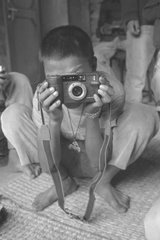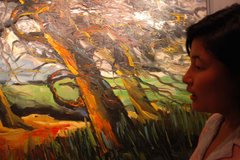

Sensuous Baby, Tripura (1970)
INTERVIEW
‘A RAGHU RAI EYE IS NO EYE!’
Raghu Rai talks to Shoma Chaudhury about his take on sensuality, passion and Indian women in his new exhibition, ‘Just by the Way’, opening in New Delhi on February 7
Photo by Aditya Kapoor
‘These nudes are a kind of poetic response to the music and rhythm of the human body. If you are a fulfilled man, you can be open about it’ What started the Just by the Way project?
I’m normally not fond of exhibitions. First, making prints was always such a painstaking affair. Secondly, no one in India really understands photography. When you read a text, you read every line. But with photographs, there’s just a glance and people turn away. They fail to understand that a photographer has gone into a situation and read every inch of space, taken in its energy and vibrations, then responded to it. You want a viewer to read those nuances. That rarely happens. But I was to have a big retrospective at the National Gallery of Modern Art. Then Amit Judge wanted me to do a show with him in his beautiful new gallery. And then the Tasveer people, who’ve opened exclusive galleries for photography in four cities, wanted a show. So I...
But what triggered the nudes? Who are your models?
Lovers, good friends... But I made those pictures over 20 years ago and had forgotten about them…
I thought you were trying to capture a new ease with sexuality in India.
No, they have a contemporary sensibility, but sexuality, sensuality, passion are all so basic to mankind. When you are a fulfilled man, you can be open about it. That picture of a baby playing with a mother’s nipples — you can see his innocent pleasure, but it is pleasure. So let’s not be hypocrites. To have a great sexual partner and sexual fulfillment is a big thing. Look at the Khajuraho masterpieces. We were so advanced, why such hypocrisy now? I thought, let there be some openness and fun.
Click on the picture below to see a photo-essay on the subject
‘If I did nudes now, they’d be completely different. I’d place women out in the open, in Indian landscapes’Why nudes with landscapes?
I didn’t have a lot of work on either rocks or nudes. When I was putting together my retrospective book, I debated on including the nudes. But they didn’t fit. What I would really have liked to do are nudes in Indian landscapes, but that was not possible. My retrospective book has an energy and charge that is all about the open life. These pictures are static and framed, shot in closed spaces. The energies didn’t match. These are poetic responses, capturing some of the rhythm and music in a human body.
If you did the nudes now, what would they be like?
They would be completely different. I’d put so much into them. I’d include Indian environments, Indian spirit, Indian energy. These portraits are isolated — if I could place Indian women in open spaces, what magic I could capture! But that’s difficult in India. (Laughs) Sad. The Kamasutra and Khajuraho were possible centuries ago. Surely one masterpiece book should be possible in this century!
How do your nudes compare with nudes by other photographers?
Everyone’s sexual needs, responses, fascinations are different. Especially with creative people — unke alag nakhre, alag madness hoti hai. And then Indian women are very special, quite unlike Western women in their body language.
Over the years, have you developed a distinct Raghu Rai eye?
Oh no, a Raghu Rai eye is no eye! I don’t want that. As I told a photographer friend recently, when I slice out a space, a moment, it should be done with such simplicity and faithfulness to life that when I give it back to life, life starts moving and flowing around it without a stutter. The purpose of photography for me is documentation. This (pointing to pictures around him) is the photo history of our time. This was how life was lived. These were the kinds of people there were. Today the asi is buying old pictures from the British library and elsewhere. In those days you had slow cameras, slow lenses. You couldn’t get candid pictures, or capture movement like we can today. But they still did such great work. Now with new technology — energy ka to jadu hai!
Have there been shifts in your own head, in the way you photograph?
My early pictures were bold, close, graphic, strong — even decorative. But when I joined journalism, I had to open it up. One was dealing with daily life, ordinary or big happenings… As I said, I wanted to capture a slice of life in a way that when you give it back, life starts moving without a stutter. That is my most basic shift. There have been other struggles. India is a very lonely, poor place, in terms of sharing creativity and learning about art. One is willing to share so much with youngsters now. In our time, there was no one to point you towards anything. So there was the struggle to move out of that poverty. And then, there is the frame (pointing to the contour of a picture). Over the years, that becomes a style. Then, a prison frame. You become a prisoner of what people have been admiring about you. That is when you must screw it, cut it, smash it, get out of it. For freedom. Life is never static. That understanding is at the core of my work. Ask me for my biggest inspiration? It is the knowledge that sun, clouds, rain — nothing’s ever the same twice.
Feb 10 , 2007









